Effects of age of acquisition and category size on signed verbal fluency
IF 1.3
3区 文学
0 LANGUAGE & LINGUISTICS
引用次数: 2
Abstract
ABSTRACT Using a free-recall paradigm, we explored the effects of age of acquisition and category size on verbal fluency in Turkish Sign Language (Türk İşaret Dili [TİD]). We studied the semantic and phonological fluency task performances of deaf native and deaf late adult signers. We measured the number of correct responses and performed a time course analysis to observe how signers engage in lexical retrieval. Each task parameter had three difficulty settings corresponding to the size of the selected phonological and semantic categories. The results show that native TİD signers produced more correct responses. However, the results reveal no relation between the age of acquisition and the retrieval rate since participants maintained close subsequent response times. This indicates that participants had similar lexical access. Furthermore, the number of signs that the participants produced decreased as the level of difficulty (as a function of category size) increased. Therefore, phonological and semantic category size was found to be a suitable measure for categorical difficulty in TİD. We conclude that both groups of signers update information in the working memory and engage in lexical access similarly, but delayed acquisition of TİD results in a smaller search set in the mental lexicon.习得年龄和类别大小对手语流利性的影响
摘要采用自由回忆范式,我们探讨了习得年龄和类别大小对土耳其手语语言流利性的影响。我们研究了本地聋人和成年聋人的语义和语音流利性任务表现。我们测量了正确回答的数量,并进行了时间过程分析,以观察签名者如何参与词汇检索。每个任务参数都有三个难度设置,对应于所选语音和语义类别的大小。结果表明,土生的TíD签名者产生了更正确的回答。然而,研究结果显示,由于参与者保持着密切的后续反应时间,因此获得年龄和检索率之间没有关系。这表明参与者具有相似的词汇访问能力。此外,随着难度的增加(作为类别大小的函数),参与者产生的迹象数量也会减少。因此,语音和语义范畴大小被发现是衡量TíD中范畴难度的合适指标。我们得出的结论是,这两组签名者更新工作记忆中的信息并进行类似的词汇访问,但延迟获取TíD会导致心理词汇中的搜索集较小。
本文章由计算机程序翻译,如有差异,请以英文原文为准。
求助全文
约1分钟内获得全文
求助全文
来源期刊

Language Acquisition
Multiple-
CiteScore
2.30
自引率
8.30%
发文量
20
期刊介绍:
The research published in Language Acquisition: A Journal of Developmental Linguistics makes a clear contribution to linguistic theory by increasing our understanding of how language is acquired. The journal focuses on the acquisition of syntax, semantics, phonology, and morphology, and considers theoretical, experimental, and computational perspectives. Coverage includes solutions to the logical problem of language acquisition, as it arises for particular grammatical proposals; discussion of acquisition data relevant to current linguistic questions; and perspectives derived from theory-driven studies of second language acquisition, language-impaired speakers, and other domains of cognition.
 求助内容:
求助内容: 应助结果提醒方式:
应助结果提醒方式:


